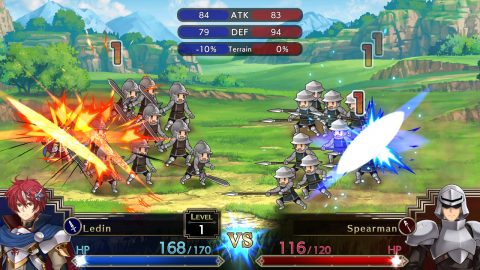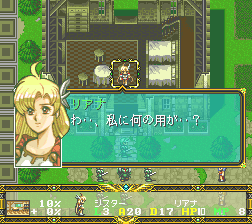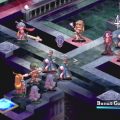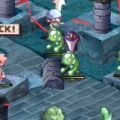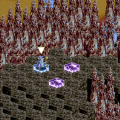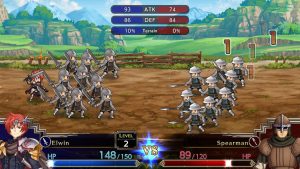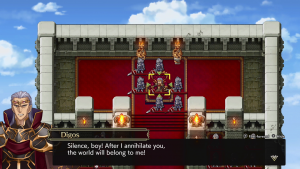- Langrisser
- Langrisser II
- Langrisser I & II (PS4/NSW)
- Langrisser III
Langrisser was one of the standout SRPGs of the 16-bit era, a combination of epic tactical battles, outstanding music, and colorful character designs by Satoshi Urushihara. While it stuck around during the 32-bit era, it never quite had the same popularity, and eventually the team transitioned to the Growlanser series, then later worked on the DS/3DS Devil Survivor titles. Nevertheless, the current license holder, Extreme, tried desperately to keep the series alive – it was resurrected for an awful 3DS game, Langrisser Re:Incarnation Tensei in 2015, likely due to the resurgence of Nintendo’s similar Fire Emblem series. While that was a flop, it hasn’t stopped the publisher from trying, first with a smartphone mobile games released in 2018, and then finally a complete remake of the first two games, released in Japan in 2019. This was developed by City Connection, a company with a reputation for updating and re-releasing retro games, like Penguin Wars and Psyvariar. The first Langrisser was localized for the Genesis under the title Warsong, but none of the other core games were published outside of Japan. The sequel, Langrisser II (Mega Drive) and its upgraded version, Der Langrisser (Super Famicom), have been fan translated, but this is the first time it’s been officially localized.
For details on the specifics of Langrisser, please check out the articles on the first game and the second game, but in brief – it’s similar to other SRPGs like Shining Force and Fire Emblem, except there are two main unit types. Commanders are unique characters and a fairly strong, and each travels with a squadron of weaker Mercenary units. While Mercenaries can fight on their own, it’s to their advantage to stay close to their Commander, because it not only boosts their strength, but also heals them slightly at the end of each turn. Given the large number of units on the battlefield, it gives the impression of a large scale conflicts compared to other games; conversely, it also means that scenarios take far longer than other similar games.
As far as the remake goes, everything has been given an HD overhaul. The most contentious are the character designs, which were redone by Nagi Ryou, also known for his work on the Ar Tonelico series. He seems to have had the misfortune of being cast as the redesigner of well-loved 90s games, because he was also put in a similar role for the 2018 remake of the adventure game YU-NO, whose artwork pleased no one. Similarly, his new artwork isn’t bad – but Satoshi Urushihara’s are not only much more distinctive but also intrinsically linked to the Langrisser series, to the point where it just doesn’t feel the same without his illustrations. Thankfully, you can switch to use the original game’s portraits in the option menu – the retail version even lets you flip the package insert to feature the original art. (These features were DLC in the Japanese version, included with a code in the package, but come pre-bundled into the software for the international release.)
On the battlefield, the sprites are given a super deformed look, with 2D skeletal animation that gives them a smooth but still unnatural feeling. They do veer a little much on the cutesy side, though that style is at least consistent with the Mega Drive version of Langrisser II. For the background tiles, you’re given the option between classic 16-bit style tiles or redrawn HD tiles – while the option is nice, the sprites aren’t changed either way, and at least they fit in more with the redrawn versions. Ultimately, it does feel a little cheap, like a smartphone game on a console.
As for the music, by default you’re given the option between the Genesis/Mega Drive versions of the songs, or newly arranged ones. In the case of the first Langrisser, this is actually notable since the 32-bit versions didn’t have the rights to the original soundtrack. The newly rearranged versions are alright, though nothing special. A DLC package includes the music from most of the other releases, including the PC Engine CD version of the first game, the PC FX version of the second, and both the PlayStation and Saturn soundtracks. Much of the dialogue is fully voiced in Japanese as well, newly recast and recorded from the old versions.
While the core game remains relatively faithful, there have been a number of rebalancing tweaks. Probably the most noticeable is that units original had a HP range of between 0 and 10, much like in the Famicom/Advance Wars games. The redone versions changes this to a larger number – for example, the hero’s Mercenaries in Langrisser II have a max HP of 150 by default. Other tweaks include how the Commanders are promoted to new classes, which no longer involve resetting their level down to one. Various difficulty rebalances have been made as well. In addition to the ability to skip skirmish animations (already included in most Langrisser games sans the very first), you can also fast forward through all of the action – story, movement, enemy turns, etc. – which helps mitigate the drawn-out missions.
The most impressive aspect of the second game was with its plot branching (introduced in Der Langrisser) with several routes through the game depending on the choices you made. This version includes all of that plus the extra scenarios previously exclusive to the Saturn version of the game. Additionally, the first game was originally linear, but this edition adds several plot branches, and with it, multiple endings. Also, previously there was a cheat command to select missions, but now a similar option is built into the game, allowing you to revisit previously beaten scenarios while keeping your stats. While this allows you to play around with different routes, when you move to a previous stage, it’s a one way trip – in other words, if you’re on the sixth mission and go back to the second, you can’t just hop back to the sixth when you’re done – you have to play the third, fourth, and fifth again as well.
There’s been a lot of consideration put into these updates beyond a mere visual makeover, and while some of the changes have been contentious among longtime Japanese fans, most of these aren’t anything English speaking fans would be familiar with. However, even though there have been plenty of quality-of-life improvements, ultimately these are still just enhanced 16-bit RPGs, and there are still some issues with the mission design and AI that will probably prove frustrating. And while the branching plot is ambitious, the stories are still kinda typical and you’re probably not going too attached to these characters. The games are still bona fide classics, but anyone looking for something distinctly modern – i.e. the 3DS and Switch Fire Emblem games – will need to temper their expectations. But they’re still the best way to play these games currently, especially for English speakers.
Comparison Screenshots



